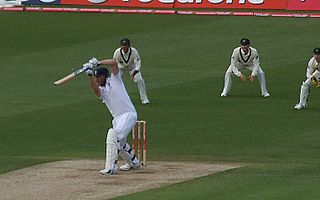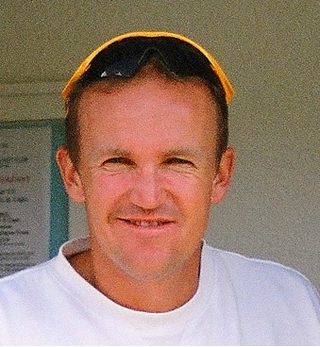Related Research Articles

The wicket-keeper in the sport of cricket is the player on the fielding side who stands behind the wicket or stumps being watchful of the batsman and ready to take a catch, stump the batsman out and run out a batsman when occasion arises. The wicket-keeper is the only member of the fielding side permitted to wear gloves and external leg guards. The role of the keeper is governed by Law 27 of the Laws of Cricket.

In cricket, a slip fielder is placed behind the batsman on the off side of the field. They are placed with the aim of catching an edged ball which is beyond the wicket-keeper's reach. Many teams employ two or three slips. A floating slip is sometimes employed, usually in limited over games, who patrols an area in the slip cordon that would ordinarily be occupied by more than one fielder. The slip cordon's distance from the batsman increases with the pace of the bowler; generally they will be marginally further away from the batsman than the wicket-keeper is. Because of the resulting geometry, spin bowlers generally have fewer slips in the cordon than a fast bowler would in an equivalent game situation. As fielding in the slips requires quick reflexes and sure hands, usually the most adept catchers in the team will make up the slip cordon. Most slip fielders are top order batsmen. Specialist slip fielders are sometimes called "slippers".

This is a general glossary of the terminology used in the sport of cricket. Where words in a sentence are also defined elsewhere in this article, they appear in italics. Certain aspects of cricket terminology are explained in more detail in cricket statistics and the naming of fielding positions is explained at fielding (cricket).

An all-rounder is a cricketer who regularly performs well at both batting and bowling. Although all bowlers must bat and quite a handful of batsmen do bowl occasionally, most players are skilled in only one of the two disciplines and are considered specialists. Some wicket-keepers have the skills of a specialist batter and have been referred to as all-rounders, but the term wicket-keeper-batter is more commonly applied to them, even if they are substitute wicket keepers who also bowl.

Parthiv Ajay Patel is a former Indian professional cricketer, wicketkeeper-batsman, and was a member of the Indian national cricket team. He is a left-handed batsman and played for Gujarat in domestic cricket. Having lost a finger at the age of 9, he initially found it hard to keep wickets, but after enough practice, he was used to it. When Parthiv played for the Indian team in 2002, he became the youngest wicket-keeper to represent a country in Tests. With the emergence of MS Dhoni as wicketkeeper-batsman, Parthiv Patel's chance of becoming the first choice keeper for India faded away.

Andrew Flower is a Zimbabwean cricket coach and a former cricketer. As a cricketer, he captained the Zimbabwe national cricket team and is widely regarded as one of the greatest wicket-keeper-batters of all time. He was Zimbabwe's wicket-keeper for more than 10 years and is, statistically, the greatest batsman the country has produced. During his peak from October to December 2001, Flower was ranked as the best Test batsman in the world. He was widely acknowledged as the only Zimbabwe batsman of proper test quality in any conditions. After retirement, he served as the coach of the English cricket team from 2009 to 2014. Flower became the second foreign coach in the team's history. Currently, he is the Head Coach of Lucknow Super Giants in Indian Premier League. He also works as the head coach of the Multan Sultans and St Lucia Kings.

In cricket, a dismissal occurs when a batter's innings is brought to an end by the opposing team. Other terms used are the batsman being out, the batting side losing a wicket, and the fielding side taking a wicket. The ball becomes dead, and the dismissed batter must leave the field of play for the rest of their team's innings, to be replaced by a team-mate. A team's innings ends if ten of the eleven team members are dismissed. Players bat in pairs so, when only one batter is not out, it is not possible for the team to bat any longer. This is known as dismissing or bowling out the batting team, who are said to be all out.

The captain of a cricket team, often referred to as the skipper, is the appointed leader, having several additional roles and responsibilities over and above those of the other players. As in other sports, the captain is usually experienced and has good communication skills, and is likely to be one of the most regular members of the team, as the captain is responsible for the team selection. Before the game the captains toss for innings. During the match the captain decides the team's batting order, who will bowl each over, and where each fielder will be positioned. While the captain has the final say, decisions are often collaborative. A captain's knowledge of the complexities of cricket strategy and tactics, and shrewdness in the field, may contribute significantly to the team's success.

Alec James Stewart is an English former cricketer, and former captain of the England cricket team, who played Test cricket and One Day Internationals as a right-handed wicket-keeper-batsman. He is the fourth-most-capped English cricketer ever in Test matches and third-most-capped in One Day Internationals (ODIs), having played in 133 Tests and 170 ODIs. An attacking batsman in tests against the new ball, Stewart is regarded as one of England's greatest openers. Legendary Pakistani fast bowler Wasim Akram considers him one of the most difficult batsmen he ever bowled to.

Adam Craig Gilchrist is an Australian cricket commentator and former international cricketer and captain of the Australia national cricket team. He was an attacking left-handed batsman and record-breaking wicket-keeper, who redefined the role for the Australia national team through his aggressive batting. Widely regarded as one of the greatest wicket-keeper-batsmen in the history of the game, Gilchrist held the world record for the most dismissals by a wicket-keeper in One Day International (ODI) cricket until it was surpassed by Kumar Sangakkara in 2015 and the most by an Australian in Test cricket.

Ian Andrew Healy is an Australian former international cricketer who played for Queensland domestically. A specialist wicketkeeper and useful right-hand middle-order batsman, he made an unheralded entry to international cricket in 1988, after only six first-class games. His work ethic and combativeness was much needed by an Australian team. Over the next decade, Healy was a key member of the side as it enjoyed a sustained period of success. By the time of his retirement, Healy held the world record for most Test dismissals by a wicket-keeper.
Rodney William Marsh was an Australian professional cricketer who played as a wicketkeeper for the Australian national team.

John McCarthy Blackham was a Test cricketer who played for Victoria and Australia.

Farokh Maneksha Engineerpronunciation (help·info) is an Indian former cricketer. He played 46 Test matches for India, played first-class cricket for Bombay in India from 1959 to 1975 and for Lancashire County Cricket Club in England from 1968 to 1976. Engineer was the last from his community to play for India, as not a single Parsee male has represented the country after him.
In cricket, the batting order is the sequence in which batters play through their team's innings, there always being two batters taking part at any one time. All eleven players in a team are required to bat if the innings is completed.
Wayne Bentley Phillips is a former Australian cricketer who played in 27 Test matches and 48 One Day Internationals (ODIs) between 1982 and 1986 as a batsman and wicket-keeper. He played for South Australia between 1978 and 1991
Denesh Ramdin is a Trinidadian cricketer who played internationally for the West Indies. He is a right-handed wicketkeeper-batsman. He retired from all forms of international cricket in July 2022.
The Australian cricket team toured India from February to April 2001 for a three-Test series and a five-match ODI series. The series is considered one of India's finest, as they secured victory against Australia in the Test series, in the process breaking Australia's 16-match win streak in Tests, and being the third side to win a Test match after being asked to follow-on during the match in Kolkata. The Kolkata match has been widely regarded as one of the greatest matches in the sport's history.
The 1965-66 Australians drew 1-1 with the touring England team in the 1965-66 Ashes series. They were strong in batting, but weak in bowling and by the end of the series had seven batsmen, an all-rounder, a wicket-keeper and only two specialist bowlers in the team, with the batsman helping out with their part-time bowling skills.
In cricket, a player's batting average is the total number of runs they have scored divided by the number of times they have been out, usually given to two decimal places. Since the number of runs a player scores and how often they get out are primarily measures of their own playing ability, and largely independent of their teammates, batting average is a good metric for an individual player's skill as a batter. The number is also simple to interpret intuitively. If all the batter's innings were completed, this is the average number of runs they score per innings. If they did not complete all their innings, this number is an estimate of the unknown average number of runs they score per innings.
References
- ↑ S Rajesh. The year of the wicketkeeper-batsman. ESPNcricinfo.
- ↑ What’s The Role Of A Wicket-keeper/Batsman. Red Bull.
- ↑ Deepu Narayana. Who Is the Greatest Wicket-keeper Batsman of All Time? Dennis Does Cricket.
- ↑ Bill Russell. The 10 Greatest Wicket-Keeper Batsmen of All Time. Sporteology.
- ↑ The Top 10 Wicket-Keepers in Cricket History. Totalsportek.
- ↑ Aadi Jalan. Ranking the top 10 wicketkeeper-batsmen of all time. Sportskeeda.